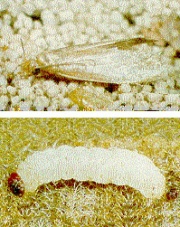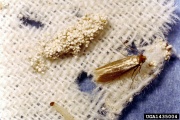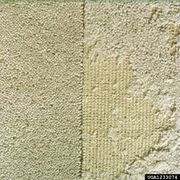Difference between revisions of "Webbing clothes moth"
m (Text replace - "[http://cameo.mfa.org/materials/ h" to "[h") |
|||
| (One intermediate revision by one other user not shown) | |||
| Line 1: | Line 1: | ||
[[File:image3_webbingclothesmoth.jpg|thumb|Webbing clothes moth, adult and larva]] | [[File:image3_webbingclothesmoth.jpg|thumb|Webbing clothes moth, adult and larva]] | ||
== Description == | == Description == | ||
| + | [[File:Webbing.clothes_moth_LC_forestryimages.org.jpg|thumb|Webbing clothes moth]] | ||
| + | A slender, elongated moth, ''Tinea bisselliella'' and related species. Webbing clothes moths are light sensitive and prefer darkened spaces such as storage cabinets and boxes. Adult webbing clothes moths are golden yellow with with a tuft of darker hair on their head. They have a wing span of 8 to 10 millimeters. Eggs hatch in 4 to 10 days then the larva feed for 30-35 days. The larvae stage feeds on [[protein|proteinaceous]] media, such as [[wool|woolen]] fabrics, [[hair|hair]], [[fur|fur]], [[hide|hides]], and [[feather|feathers]]. The 8-10 mm long white larvae leave a trail of silk as they graze. They pupate into moths in 8 to 28 days then just live long enough to mate and lay new eggs (4 to 7 days). | ||
| − | + | [[File:Webbing.clothes_moth_damage_forestryimages.org.jpg|thumb|Webbing clothes moth damage]] | |
| − | |||
| − | [[File:Webbing. | ||
== Synonyms and Related Terms == | == Synonyms and Related Terms == | ||
clothes-moth; tineid moth; webbing clothes moth (Tineola bisselliella); casemaking clothes moth (Tinea pellionella); white-tip clothes moth (Trichophaga tapetzella) | clothes-moth; tineid moth; webbing clothes moth (Tineola bisselliella); casemaking clothes moth (Tinea pellionella); white-tip clothes moth (Trichophaga tapetzella) | ||
| − | == | + | ==Physical and Chemical Properties== |
| − | |||
| − | |||
| − | |||
| − | |||
| − | |||
| − | |||
| − | |||
| − | |||
| − | + | * Not attracted to black light or artificial light. | |
| + | * Detected by damaged fabrics, frass, and/or silken webs. | ||
| − | + | ==Resources and Citations== | |
| − | |||
| − | |||
| + | * MuseumPests.net: [http://www.museumpests.net/pdfholder/25image.pdf Webbing Clothes Moth] | ||
| − | + | * L. Zycherman, J.R. Schrock, ''A Guide to Museum Pest Control'', FAIC, Washington, DC, 1988. | |
| − | * | + | * R.Norton, "A Case History of Managing Outbreaks of Webbing Clothes Moth" ICOM Preprints, Edinburgh 1996, Vol. I, pp. 61-67. |
| − | * ''Encyclopedia Britannica'', http://www.britannica.com Comment: "tineid moth." | + | * ''Encyclopedia Britannica'', http://www.britannica.com Comment: "tineid moth." Accessed 13 Oct. 2004. |
[[Category:Materials database]] | [[Category:Materials database]] | ||
Latest revision as of 14:21, 26 June 2022
Description
A slender, elongated moth, Tinea bisselliella and related species. Webbing clothes moths are light sensitive and prefer darkened spaces such as storage cabinets and boxes. Adult webbing clothes moths are golden yellow with with a tuft of darker hair on their head. They have a wing span of 8 to 10 millimeters. Eggs hatch in 4 to 10 days then the larva feed for 30-35 days. The larvae stage feeds on proteinaceous media, such as woolen fabrics, Hair, Fur, hides, and feathers. The 8-10 mm long white larvae leave a trail of silk as they graze. They pupate into moths in 8 to 28 days then just live long enough to mate and lay new eggs (4 to 7 days).
Synonyms and Related Terms
clothes-moth; tineid moth; webbing clothes moth (Tineola bisselliella); casemaking clothes moth (Tinea pellionella); white-tip clothes moth (Trichophaga tapetzella)
Physical and Chemical Properties
- Not attracted to black light or artificial light.
- Detected by damaged fabrics, frass, and/or silken webs.
Resources and Citations
- MuseumPests.net: Webbing Clothes Moth
- L. Zycherman, J.R. Schrock, A Guide to Museum Pest Control, FAIC, Washington, DC, 1988.
- R.Norton, "A Case History of Managing Outbreaks of Webbing Clothes Moth" ICOM Preprints, Edinburgh 1996, Vol. I, pp. 61-67.
- Encyclopedia Britannica, http://www.britannica.com Comment: "tineid moth." Accessed 13 Oct. 2004.


